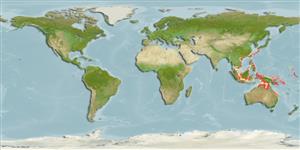Environment: milieu / climate zone / depth range / distribution range
Écologie
marin; saumâtre benthopélagique. Tropical
Distribution
Pays | Zones FAO | Écosystèmes | Occurrences | Point map | Introductions | Faunafri
Western Pacific: Australia.
Taille / Poids / Âge
Maturity: Lm ? range ? - ? cm
Description synthétique
Clés d'identification | Morphologie | Morphométrie
Épines dorsales (Total) : 6; Rayons mous dorsaux (Total) : 43 - 52; Rayons mous anaux: 35 - 45. Distinguished by the following characteristics: total elements in dorsal fin 43-52; total anal-fin elements 35-45, first element spinous or segmented; pectoral-fin rays 16-20; anal-fin pterygiophores preceding the first hemal spine (AP) 3-5; pelvic-fin length (PEL)/HL 0.463-0.750 ; scales absent from anteriormost 30% of head and body, scales extending posteriorly from the vertical with 3rd or 4th dorsal-fin spine; 10-23 teeth in outer row of upper jaw; 14-25 teeth in outer row of lower jaw; jaws terminating posteriorly at a vertical with posterior naris; anterior nares slightly closer together than posterior nares (Ref. 50587).
Life cycle and mating behavior
Maturité | Reproduction | Frai | Œufs | Fécondité | Larves
Eschmeyer, W.N. (ed.), 2001. Catalog of fishes. Updated database version of December 2001. Catalog databases as made available to FishBase in December 2001. (Ref. 40966)
Statut dans la liste rouge de l'IUCN (Ref. 130435: Version 2024-2)
Menace pour l'homme
Harmless
Utilisations par l'homme
Outils
Articles particuliers
Télécharger en XML
Sources Internet
Estimates based on models
Preferred temperature (Ref.
123201): 25 - 28.9, mean 27.8 °C (based on 366 cells).
Phylogenetic diversity index (Ref.
82804): PD
50 = 0.6250 [Uniqueness, from 0.5 = low to 2.0 = high].
Bayesian length-weight: a=0.01000 (0.00244 - 0.04107), b=3.04 (2.81 - 3.27), in cm total length, based on all LWR estimates for this body shape (Ref.
93245).
Niveau trophique (Ref.
69278): 3.5 ±0.4 se; based on size and trophs of closest relatives
Résilience (Ref.
120179): Haut, temps minimum de doublement de population inférieur à 15 mois (Preliminary K or Fecundity.).
Fishing Vulnerability (Ref.
59153): Low vulnerability (10 of 100).
